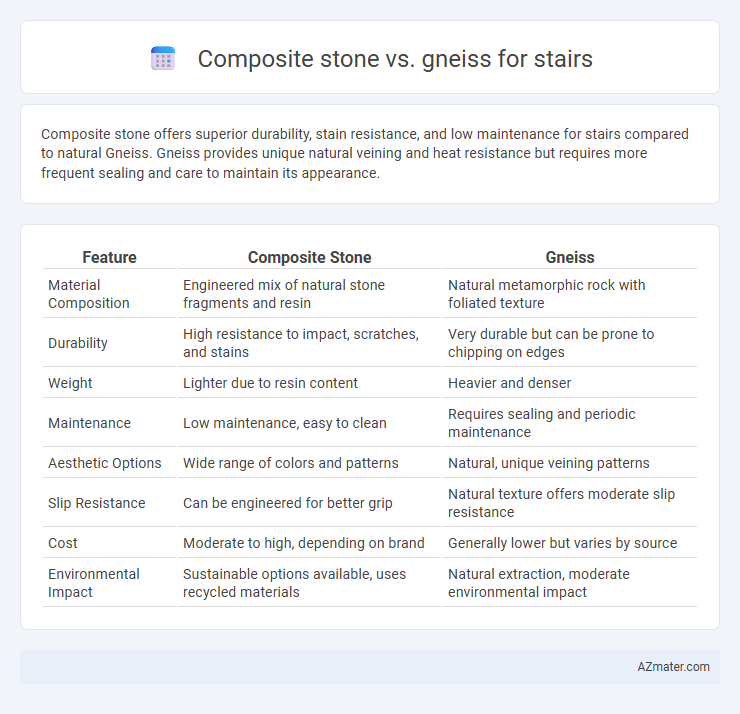Composite stone offers superior durability, stain resistance, and low maintenance for stairs compared to natural Gneiss. Gneiss provides unique natural veining and heat resistance but requires more frequent sealing and care to maintain its appearance.
Table of Comparison
| Feature | Composite Stone | Gneiss |
|---|---|---|
| Material Composition | Engineered mix of natural stone fragments and resin | Natural metamorphic rock with foliated texture |
| Durability | High resistance to impact, scratches, and stains | Very durable but can be prone to chipping on edges |
| Weight | Lighter due to resin content | Heavier and denser |
| Maintenance | Low maintenance, easy to clean | Requires sealing and periodic maintenance |
| Aesthetic Options | Wide range of colors and patterns | Natural, unique veining patterns |
| Slip Resistance | Can be engineered for better grip | Natural texture offers moderate slip resistance |
| Cost | Moderate to high, depending on brand | Generally lower but varies by source |
| Environmental Impact | Sustainable options available, uses recycled materials | Natural extraction, moderate environmental impact |
Introduction: Composite Stone vs Gneiss for Stair Construction
Composite stone offers enhanced durability and uniformity, making it ideal for stair construction where consistent appearance and resistance to wear are essential. Gneiss, a natural metamorphic rock, provides unique aesthetic patterns and excellent toughness but may require more maintenance due to its natural fissures. Selecting between composite stone and gneiss hinges on balancing the need for durability, aesthetic preference, and long-term maintenance considerations in stair design.
Material Composition and Formation
Composite stone for stairs consists of engineered materials like crushed natural stone bound with resins and polymers, offering uniformity and customizable aesthetics. Gneiss is a metamorphic rock formed under intense heat and pressure, characterized by its foliated texture and natural mineral banding, providing durability and unique patterns. The engineered composition of composite stone allows for greater design flexibility, whereas gneiss's natural formation results in inherent strength and distinctive visual appeal.
Aesthetic Appeal and Design Versatility
Composite stone offers a consistent texture and color palette, allowing for sleek, modern stair designs with high customization potential. Gneiss, characterized by its natural banding and unique mineral patterns, provides a rich, earthy aesthetic ideal for traditional or rustic styles. The inherent variability of gneiss delivers one-of-a-kind visual interest, while composite stone ensures uniformity and adaptability in tailored architectural applications.
Durability and Strength Comparison
Composite stone for stairs offers exceptional durability due to its engineered composition, which resists chipping, cracking, and staining better than natural stones. Gneiss, a natural metamorphic rock, provides inherent strength and a unique grain structure but may be more prone to surface wear and requires periodic sealing to maintain longevity. When comparing strength, composite stone typically exhibits higher tensile strength and impact resistance, making it a more reliable option for heavy foot traffic areas in stair applications.
Slip Resistance and Safety Features
Composite stone offers superior slip resistance for stair applications due to its textured surface and anti-slip additives, enhancing safety in wet or high-traffic areas. Gneiss, a natural metamorphic rock, provides moderate slip resistance but may become slippery when polished or wet, requiring additional treatment for improved traction. Safety features in composite stone often include integrated grip-enhancing properties and consistent surface quality, whereas gneiss stairs depend on surface finishing and maintenance to maintain secure footing.
Maintenance Requirements and Longevity
Composite stone offers low maintenance requirements due to its resistance to stains, scratches, and weathering, making it ideal for high-traffic staircases. Gneiss, a natural stone, requires regular sealing and periodic cleaning to prevent moisture absorption and maintain its appearance. In terms of longevity, gneiss is highly durable and can last decades with proper care, while composite stone combines durability with easier upkeep, potentially extending its lifespan in outdoor or heavily used stair applications.
Cost Analysis: Budget Considerations
Composite stone offers a more budget-friendly option for stair construction compared to gneiss, with prices typically ranging from $30 to $70 per square foot, making it ideal for cost-conscious projects. Gneiss, known for its natural durability and unique veining, commands higher prices between $50 and $120 per square foot, reflecting its premium stone status and longer lifespan. When factoring in installation costs and maintenance, composite stone generally results in lower overall expenses while gneiss may provide greater long-term value due to its robustness and aesthetic appeal.
Installation Process and Complexity
Composite stone stairs offer a streamlined installation process due to their uniform material composition and pre-fabricated sizes, reducing on-site adjustments and labor time. In contrast, gneiss requires skilled craftsmanship for cutting and fitting because of its natural, uneven texture and variability, increasing installation complexity and duration. The precision needed for gneiss stair installation often demands specialized tools and experience to ensure structural integrity and aesthetic appeal.
Sustainability and Environmental Impact
Composite stone for stairs offers enhanced sustainability through the use of recycled materials and lower carbon emissions during manufacturing, contributing to reduced environmental impact compared to natural stones. Gneiss, a natural metamorphic rock, requires significant quarrying and processing, leading to higher energy consumption and habitat disruption. Choosing composite stone supports eco-friendly construction by minimizing resource depletion and promoting durability with less maintenance over time.
Conclusion: Choosing the Best Material for Stair Projects
Composite stone offers superior durability and low maintenance, making it ideal for high-traffic stair projects requiring consistent appearance and resistance to stains. Gneiss, a natural metamorphic rock, provides exceptional strength and unique veining patterns, delivering aesthetic appeal and long-lasting structural integrity. For stair designs prioritizing cost-effectiveness and customization, composite stone excels, while gneiss suits projects demanding authentic natural stone elegance and robustness.

Infographic: Composite stone vs Gneiss for Stair
 azmater.com
azmater.com